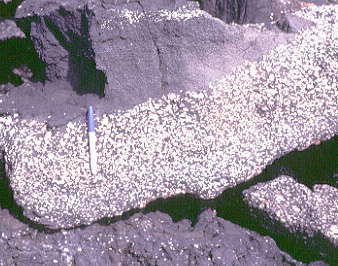|
Description of the Galapagos Islands Isla Pinta  | | A picture of abingtonite found on Pinta Island. Picture source: http://www.geo.cornell.edu/geology/GalapagosWWW/Pinta.html |
Pinta, also known as Abington,Island is an elongate shield rising from a northwest trending submarine ridge. The summit, at 850 m elevation, has a small collapse pit, but no caldera is present. The island has steep slopes, which may be due to faulting. Pinta appears to have had a two stage development: a shield stage, which began more than 800,000 years ago, and a younger fissure stage. The latter has produced many young lavas and cinder cones at the northern and southern ends of the island. There has been one recorded eruption in the past century.
Many of the lavas erupted during the shield stage have very abundant large white crystals of plagioclase. While plagioclase is common in basaltic lavas, the remarkable abundance and size of these crystals is extremely unusual. Rocks such as these have been given the name "abingtonite" after the island. Abingtonites are occasionally found elsewhere in the Galapagos, particularly on neighboring northern islands. Plagioclase is often lighter than basaltic magmas from which they crystallize. The formation of abingtonites most likely involves the concentration of plagioclase in the tops of magma chambers through floatation.
Most Galapagos magmas seem to be derived from a mixture of material from the Galapagos mantle plume and ambient upper mantle.Geochemically, Pinta magmas represent the northern extreme of the range of compositions observed in the Galapagos, indicating they are derived mostly from the Galapagos mantle plume. This contrasts with magmas from neighboring Marchena and Genovesa, which are derived mostly from the ambient upper mantle.
The Last of His Race
Pinta once had a thriving tortoise population, but the population was decimated by whalers and fisherman. The introduction of goats to the island by fisherman in 1958 may have been the last straw. At present, there is only one surviving member of this race, a male named "Lonesome George" who is held at the Darwin Research Station. For years it was hoped a mate of the same race could be found for George. When that was given up, several females, related in the sense that they were "saddlebacks" but nevertheless of different races, were placed in George's pen, but George showed little interest in mating. Other efforts to encourgage George to mate also failed. At present it seems that when George dies, so will the Pinta race of giant tortoises.
|







